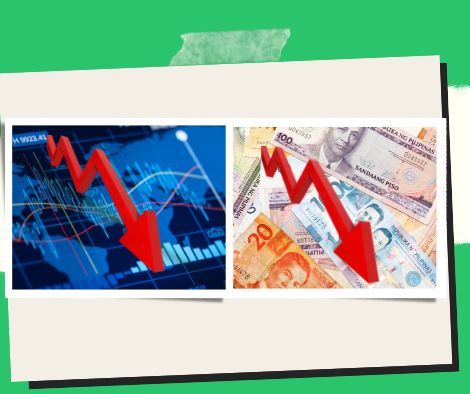
Before the BSP rate-setting meeting, stocks decline and the peso declines.
Prior to the Bangko Sentral ng Pilipinas (BSP) rate-setting meeting later this week, the local stock exchange’s main index closed Monday in the red, and the peso fell versus the US dollar.
To reach 6,838.76 points, the Philippine Stock Exchange index (PSEi) lost 0.55 percent, or 38.03 points.
To reach 3,642.96 points, All Shares decreased by 0.28 percent, or 10.21 points.
Holding Firms fell by 1.22 percent, Property fell by 0.52 percent, and Services fell by 0.40 percent, accounting for half of the sectoral gauges that tracked the PSEi.
However, mining and oil saw a 0.43 percent increase, industrial saw a 0.20 percent increase, and financials saw a 0.05 percent increase.
A little more than 1 billion shares, or PHP6.6 billion, were traded.
101 out of 99 shares were in favor of advancers, while 39 were unchanged.
Philippine equities were sold to start the week, according to Luis Limlingan, head of sales at Regina Capital Development Corporation (RCDC), as investors remained focused on the MB’s (Monetary Board) policy-setting meeting on February 16.
In terms of whether the BSP will rate the benchmark rates at a slower pace of 25 bps (basis points) or keep the adjustment level at 50 bps, he added, “economists are currently divided.”
This is because the domestic inflation rate, which was previously predicted to be the pinnacle for this round of elevated inflation rates for the country, increased further to 8.7% percent in January from the 8.1 percent recorded in the previous month.
In contrast, the peso closed Friday’s trading session at 54.42 to the dollar, down from 54.76 today.
It started the day at 54.5, which was higher than the 54.65 start of the prior session.
It fluctuated between 54.87 and 54.5, with an average of 54.702 as a consequence.
Volume totaled USD955.85 million, which is less than the USD1.25 billion from the week’s conclusion.
Michael Ricafort, chief economist at Rizal Commercial Banking Corporation (RCBC), attributed some of the peso’s weakness to geopolitical tensions between the US and China, hawkish remarks from Federal Reserve officials, expectations of additional rate hikes from the Fed, and the effects of the higher-than-anticipated domestic inflation rate in January.
Additionally, according to him, investors anticipate that the BSP would increase its benchmark rates this week by at least 25 basis points, “matching the +0.25 most recent Fed rate hike on February 1,” and “may also still match any subsequent Fed rate hikes.”
According to Ricafort, the peso will fluctuate on Tuesday between 54.65 and 54.85 to the US dollar.
Save/Share this story with QR CODE
Disclaimer
This article is for informational purposes only and does not constitute endorsement of any specific technologies or methodologies and financial advice or endorsement of any specific products or services.
📩 Need to get in touch?
Feel free to Email Us for comments, suggestions, reviews, or anything else.
We appreciate your reading. 😊Simple Ways To Say Thanks & Support Us:
1.) ❤️GIVE A TIP. Send a small donation thru Paypal😊❤️
Your DONATION will be used to fund and maintain NEXTGENDAY.com
Subscribers in the Philippines can make donations to mobile number 0917 906 3081, thru GCash.
3.) 🛒 BUY or SIGN UP to our AFFILIATE PARTNERS.
4.) 👍 Give this news article a THUMBS UP, and Leave a Comment (at Least Five Words).
AFFILIATE PARTNERS

World Class Nutritional Supplements - Buy Highest Quality Products, Purest Most Healthy Ingredients, Direct to your Door! Up to 90% OFF.
Join LiveGood Today - A company created to satisfy the world's most demanding leaders and entrepreneurs, with the best compensation plan today.



 Business Technology, Finance Technology & Information Technology
Business Technology, Finance Technology & Information Technology





